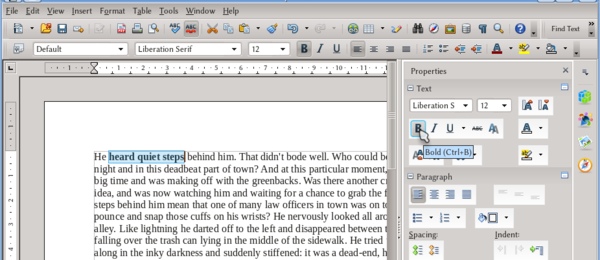Inserting text in Writer
Template:Documentation/DraftPage
Contents
Writer's User Interface
As already discussed in the chapter Apache OpenOffice User Interface, there are several menus and toolbars available.
By default, Writer displays with the option "Print Layout" that shows something similar to the output of the document. The difference between what is shown on screen and what is printed is centered on two points: the first shown in the previous screenshot, the second is discussed below.
- Borders: the text area border, the cell borders on a table (even if the table is configured to not have borders), OLE object borders... will show in grey to help the author during editing. Those borders will not be printed nor exported to PDF. It is possible to change the color of those borders (or eliminate them completely) under Tools → Options → OpenOffice → Appearance: there are options for "Text boundaries", "Object boundaries" and "Table boundaries".
- Objects inserted automatically: the table of contents and the fields show a grey background. Again, this background is not printed nor exported to PDF and it is there only during editing. To modify that background, in the same Appearance menu there are separate options for "Field shadings" and "Index and table shadings"
Writer's Sidebar
We already introduced the Sidebar on a previous section. Writer offers four decks, represented by the four icons on the right of the sidebar:
- Properties: with this deck it is possible to access to several options that performs direct formatting on the document. There are panel contents for:
- Text: Quickly modify the font, it size, its properties (bold, italic, underline, color, background, spacing, superscript, subscript...)
- Paragraph: Alignment, quick numbered lists or bullets, paragraph background, indent, spacing...
- Page: Page orientation, size, number of columns, margins.
- Styles and Formatting: also available as stand alone panel, this deck offers the possibility to manage the styles used on the document, applying existing styles, creating new ones or modifying them. We will come back to the styles and formatting tool here: Styles on Apache OpenOffice Writer.
- Gallery: also available as stand alone panel, this deck offers the possibility to add to the document images and diagrams included on the Apache OpenOffice library. The Gallery is separated on two part, the first one used to classify the images (Arrows, Background, Diagrams...) and the second one displaying the images on the selected category. With the New Theme button it is possible to create new categories. To insert an image on a document (or add a new image to the gallery) just drag and drop the selected image.
- Navigator: also available as stand alone panel, this deck offers the possibility to "browse" the document and reorganize its content by selecting different content categories, like headings, tables, frames, graphics, etcetera. You can find more information about the Navigator here: The Navigator
Working with text
Either the toolbars, sidebar and menus (normal and contextual) offer options to modify text. It is possible to modify the paragraph as a whole or the selected text with Format → Paragraph/Character or with a right click → Paragraph/Character. The available options are clear and will be discussed when talking about paragraph and character styles.
Both the Format menu and the right click offer an option to modify the page, adding for example headers and footers, page size, and so fourth. But it is important to note that these options only modify the corresponding page style: in Writer there is no direct formatting for pages, page formatting can only be done through styles. For this reason, we will leave the analysis about how to format pages to the corresponding section for page styles in this guide.
Numbered list and bullets
On the format toolbar there are two buttons that toggle numbered lists or bullets.
It is also possible to toggle the numbering on a particular paragraph pressing F12 , while ⇧ Shift + F12 toggles the bullets.
With the numbering or the bullets active, a contextual toolbar will be presented
The buttons, numbered on the screenshot, perform the following actions:
- Numbering (can be used to change bullets to numbering)
- Bullets (can be used to change numbering to bullets)
- Disable
- Promote one level
- Demote one level
- Promote one level with sub-points
- Demote one level with sub-points
- Insert an unnumbered entry
- Move line up
- Move line down
- Move line up with all its sub-points
- Move line down with all its sub-points
- Restart numbering
- Properties of the list
The options available when pressing the last button are the same available when editing a list style, so they will be discussed later.
The "sub-points" mentioned earlier are to give "levels" to a numbered list or bullet, building list like the following example
- First
- Sub First
- Second
- Sub Second
- Sub Sub Second
- Sub Second
To change the level of one line in the list, it is possible to use button 4 and 7, or with the cursor at the beginning of the line Tab ⇆ and ⇧ Shift + Tab ⇆ .

